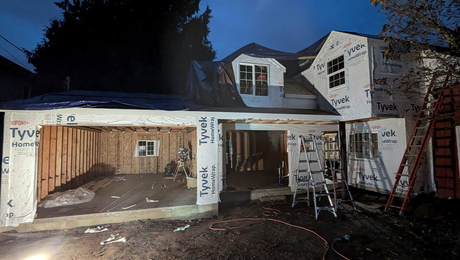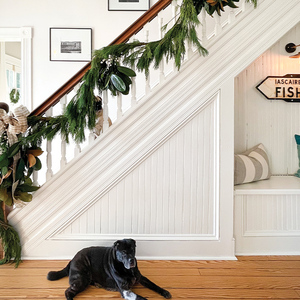Just finished a job were the HVAC contractor broke the UV light moving the unit. The homeowner wants it replaced. The HVAC guys says the one they had was worthless. I trust him, smart guy ( worked on Nuke Subs before becoming HVAC contractor) He says the light really needs to be on the return side before the coil. Any thoughts or ideas.















Replies
Doesn't change the fact that he broke it. He fixes it. If he wants to reposition it, that's a change order.
UV light for what??
anti-microbial
.
William the Geezer, the sequel to Billy the Kid - Shoe
anti microbial ... for what??
Some people just can't stand those little tiny bials.
The modern conservative is engaged in one of man's oldest exercises in moral philosophy; that is, the search for a superior moral justification for selfishness. -John Kenneth Galbraith
Next time you're in a commercial establishment, like a fast food place, or their bathroom, look for strange lights that seem very inefficient. UV is an excellent micro bug killer. It would even take out anthrax (why the Post Office was so slow recognizing that ancient fact, who knows). In the old days, they had bulbs that slipped into rental shoes at bowling alleys to kill bacteria. Interestingly, I don't remember any shield. UV is a quick way to fry the eyes, so needs to be shielded from direct view. That's why some of the commercial lights, such as are used to light the outdoors, can be dangerous when they break.
The mercury vapor lights that caused problems if broken are now supposed to be equipped with a fuse that blows if they outer shell is broken.
The modern conservative is engaged in one of man's oldest exercises in moral philosophy; that is, the search for a superior moral justification for selfishness. -John Kenneth Galbraith
I've worked in commercial buildings for 28 years, now. Never saw this technology in action. I'm quite familiar with the use of the technology to kill microbes ... but mostly in e.g. water treatment systems. Never in air side systems. I've done lots of work in hospitals of all sizes. Never seen their use. Learn something every day. Interesting.
I'm skeptical, too of their benefit ... particularly in a AHU in a residence. Of all the sources of microbes, we choose to treat air going through a fan? It seems if you feel you have microbes moving back through the return air ... there are other problems/issues at hand.
Don't understand why there would be a concentration of microbes in a return air stream. Take care of the source, I would think.
> Take care of the source, I would think.Yeah, but that causes too many sunburned butts.
The modern conservative is engaged in one of man's oldest exercises in moral philosophy; that is, the search for a superior moral justification for selfishness. -John Kenneth Galbraith
The UV light is sold to "disinfect" the air moving through the air handler. The effectiveness of this approach is suspect, and the usefulness even more so, but some people just gotta have them.
The modern conservative is engaged in one of man's oldest exercises in moral philosophy; that is, the search for a superior moral justification for selfishness. -John Kenneth Galbraith
I could see why the effectiveness of UV in heat systems would be suspect. The air moves at a high rate the exposure to the light would be minimal, unless there was a long bank of lights, I suspect it takes a bit more than casual exposure to kill bacteria. The lights used for shoes had to be left on for several seconds, if not minutes (it's been forty years since I've seen one).Many of the ozone machines of yesteryear used UV to produce ozone.
FWIWPopular Mechanics sez:UV Disinfectors
These UV light units are really quite simple. They consist of a plastic base that mounts on the ductwork, wiring for the power supply from a 120-volt outlet, an indicator light and a UV tube. The back of the base has a flexible gasket to keep harmful UV light from leaking out.The two light probes we used are similarly built, but they have different functions. The longer probe, installed in the return duct, is designed to kill airborne bacteria in the system. The other, installed in the plenum, focuses on the slimy molds that grow on air-conditioner evaporator coils. These molds can generate allergic reactions and they're responsible for the "dirty sock" odor common to air conditioners.While the lights last three to four years, they lose about 10 percent of their effectiveness per month, so you'll need to replace the bulbs about once a year. A replacement tube runs about $100. The light in the return-air duct should be used continuously, but the plenum light needs to be on only during the air-conditioning season.We chose Honeywell Enviracaire Elite UV lights (Models UV100E1001 and UV100E1027). We paid about $815 for both units.
http://www.popularmechanics.com/home_journal/home_improvement/1275931.html?page=3And some "anti" folks (note they're pulling a strong man argument - to the extent that UV isn't sold as a "whole house air cleaner), and seem a bit under-informed)Myth #4. Whole house ultra-violet (UV) light systems for central air conditioning units - These ultra-violet light systems are installed into air conditioning systems to kill mold and bacteria. They do not remove dust, particulates or airborne allergens from the A/C system, air ducts or from the indoor environment! These units are supposed to be installed so the ultra-violet lights are shining onto the evaporator coil on the air return intake side to prevent mold and bacteria growth on the evaporator coil and surrounding area, yet many of these units are installed improperly into areas of the air handler or air plenum where they can not do much good. Beware of UV light systems that produce ozone! Many of these UV light systems produce ozone at levels that cannot be controlled! Too much ozone can be an irritant to people with asthma and lung problems! I have experienced ozone producing UV light systems that created so much ozone it burned my eyes and throat. And I do not have asthma or any lung problems at all! Some of these units are also produced with non-ozone producing UV bulbs. However please note, if an air conditioning system is clean and installed properly and it has a high quality self charging electrostatic or pleated air filter in it to protect the air handler and evaporator coil from dust, the chance of the evaporator coil and the rest of the system becoming contaminated with dirt, mold and bacteria will be greatly reduced. We recommend properly cleaning your air conditioning system and duct work while installing an upgraded quality air filter instead of a ultra-violet light system. Please know that ultra-violet Light units for your air conditioning system are not whole house air cleaners even though people will claim that they will keep your entire home clean!http://www.aircleaners.com/wholehouse.phtmlAnd this from the "Allergy Buyers Club" (!!!)A disclaimer from one of the air filter review sites says it best:
?The actual effectiveness of an air purifier depends on a variety of
factors including, the amount of air that the air purifier processes,
the nature of the pollutant, and the rate at which the pollutant is
being introduced into the environment.
Additionally, there is no guarantee that an individual who suffers
from allergies or other respiratory problems will derive a discernible
reduction in symptoms through the use of these or other air purifiers.
Whether individuals will derive such relief depends on many variables,
including the source and severity of their allergies, whether the
allergens at issue tend to remain airborne, the rate at which the
allergens are emitted into their homes or offices, and other
environmental factors.?
http://www.allergybuyersclub.com/compare-safe-room.html
"Ask not what the world needs. Ask what makes you come alive... then go do it. Because what the world needs is people who have come alive."
Howard Thurman
Thanks for the great post. I knew what the UV bulbs did, but did not know their dedicated purpose in systems, which, as you described it, makes perfect sense. Anything else would seem more gimmick than anything else.As your post indicates, a good air cleaning system would need to address more than one concern. UV only affects living organisms and does nothing to clean the air. Even if you've killed microscopic critters, you are still going to have them floating about the system, until they are mechanically removed.For air cleaning, we have a lot of options. Obviously, we always start with removal of dust, pollen and other large matter from the air. Even to do this, we can approach the matter in stages. For example: First, a washable screen to trap hair and such. Second, the air may be an electrostatic or mechanical, such as the fiber, or pleated filter we commonly find downtown. Third, we could install a filter that allows only small micron sized objects to pass. Fourth, we might add a charcoal filter to trap odors. Finally, we could treat air moving through the system with UV, but I imagine it would be expensive, since it would take an array of bulbs over a long run to have a notable effect on bacteria passing through the system.Needless to say, it's going to take some power to push air through this system and a failure to maintain filters is going to show quickly on the system load and efficiency. As well, the cost of replacing bulbs would be significant.
The primary benefit of UV-C lights is to keep coils cleaner. Trane's position on the subject is based on the current acknowledgement "
Over the last few years, the claimed value and benefits of UV-C have moved
away from occupant health benefits to keeping equipment clean and
maintaining HVAC system efficiency."
The location should be upstream of the cooling coil.
Darn NUKES, cant trust 'em. Was he a wire biter or a knuckle dragger?